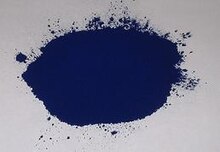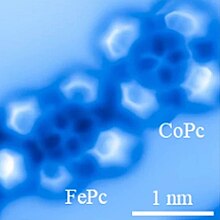Copper phthalocyanine

| |
| Names | |
|---|---|
| IUPAC name
(29H,31H-phthalocyaninato(2−)-N29,N30,N31,N32)copper(II)
| |
| Other names
Copper(II) phthalocyanine
Monastral blue Phthalocyanine blue Phthalo blue Thalo blue Pigment Blue 15 | |
| Identifiers | |
3D model (JSmol)
|
|
| ChEBI | |
| ChemSpider | |
| ECHA InfoCard | 100.005.169 |
PubChemCID
|
|
| UNII | |
CompTox Dashboard(EPA)
|
|
| |
| |
| Properties | |
| C32H16CuN8 | |
| Molar mass | 576.082g·mol−1 |
| Appearance | dark blue solid |
| Related compounds | |
Othercations
|
Lead(II) phthalocyanine |
Except where otherwise noted, data are given for materials in theirstandard state(at 25 °C [77 °F], 100 kPa).
| |
| Phthalo blue | |
|---|---|
 Phthalocyanine blue pigment powder | |
| Hex triplet | #000F89 |
| sRGBB(r,g,b) | (0, 15, 137) |
| HSV(h,s,v) | (233°, 100%, 54%) |
| CIELChuv(L,C,h) | (16, 61, 265°) |
| Source | The Mother of All HTML Colo(u)r Charts |
| ISCC–NBS descriptor | Vivid blue |
| B:Normalized to [0–255] (byte) H:Normalized to [0–100] (hundred) | |
Copper phthalocyanine(CuPc), also calledphthalocyanine blue,phthalo blueand manyother names,is a bright, crystalline, synthetic bluepigmentfrom the group ofdyesbased onphthalocyanines.Its brilliant blue is frequently used inpaintsanddyes.It is highly valued for its superior properties such as light fastness, tinting strength, covering power and resistance to the effects ofalkalisandacids.It has the appearance of a blue powder, insoluble in most solvents including water.
History[edit]
The discovery of metal phthalocyanines can be traced to the observation of intensely colored byproducts from reactions ofphthalic acid(benzene-1,2-dicarboxylic acid) or its derivatives with sources of nitrogen and metals. CuPc (copper phthalocyanine) was first prepared in 1927 by the reaction ofcopper(I) cyanideando-dibromobenzene,which mainly produces colorlessphthalonitrileas well as an intensely blue by-product. A couple of years later, workers at Scottish Dyes observed the formation of traces of phthalocyanine dyes in the synthesis ofphthalimideby the reaction ofphthalic anhydrideandammoniain the presence of metallic iron. In 1937,DuPontstarted producing copper phthalocyanine blue in the USA under the trade nameMonastral Blueafter it had been previously launched in Great Britain (ICI) and Germany (I.G. Farbenindustrie) in 1935.[1]
Difficulty was experienced in forming stabledispersionswith the first Alpha forms, especially in mixtures withrutiletitanium,where the blue pigment tended toflocculate.The beta form was more stable, as was the improved stabilized Alpha form. Today, there are even more isomeric forms available.
Synonyms and trade names[edit]
The substance,IUPACname (29H,31H-phthalocyaninato(2−)-N29,N30,N31,N32)copper(II), is known by many names[2]such asmonastral blue,phthalo blue,helio blue,[3]thalo blue,Winsor blue,[4]phthalocyanine blue,C.I.Pigment Blue 15:2,[5][6]copper phthalocyanine blue,[7]copper tetrabenzoporphyrazine,[8]Cu-phthaloblue,[9]P.B.15.2,[10][11][12]C.I. 74160,[13][14][15]andBritish RailBlue.[16]Numerous other trade names and synonyms exist.[17]The abbreviation "CuPc" is also used.[18]
Manufacture[edit]
Two manufacturing processes have gained commercial importance for the production of copper phthalocyanine:
- Thephthalonitrileprocess, mainly used in Germany
- Thephthalic anhydride/ureaprocess, developed in Great Britain and in the USA.
Both approaches can be carried out either without (baking process) or with a solvent (solvent process). Higher yields may be achieved with the solvent process (> 95%) than with the baking process (70 to 80%), so that the solvent process has initially simulated more interest. However, recents trends show a reverse tendency for the baking process mainly on the grounds of economical and ecological concerns (solvent-free, shorter lead time).
Phthalonitrile process[edit]
This approach involves heatingphthalonitrilewith a copper salt, usuallycopper(I)chlorideat 200°C to 240°C. The gross reaction equation fromphthalonitrilemay be written as follows:
Phthalic anhydride/urea process[edit]
The gross reaction equation fromphthalic anhydrideandureamay be written as follows:
Applications[edit]

Catalysis[edit]
Metal phthalocyanines have long been examined as catalysts for redox reactions. Areas of interest are theoxygen reduction reactionand the sweetening of gas streams by removal ofhydrogen sulfide.[citation needed]
Colorant[edit]
Due to its stability, phthalo blue is also used ininks,coatings, and manyplastics.The pigment is insoluble and has no tendency to migrate in the material. It is a standard pigment used in printing ink and the packaging industry. Industrial production was of the order of 10,000 tonnes per annum in the 1980s and 1990s in Japan alone.[17]The pigment is the highest volume pigment produced.[19]
All major artists' pigment manufacturers produce variants of copper phthalocyanine, designatedcolor index PB15 (blue)andcolor indexes PG7 and PG36 (green).
A common component on the artist's palette, phthalo blue is a cool blue with a bias towards green. It has intense tinting strength and easily overpowers the mix when combined with other colors. It is a transparent staining color and can be applied using glazing techniques.
It is present in a wide variety of products,[20]such as color deposition hair conditioner,[21]gel ink pens, eye patches, parfum, shampoo, skin-care products, soap, sunscreen, tattoo ink,[22]toothpaste,[23]and even turf colorants.[24]
Research[edit]
CuPc has often been investigated in the context ofmolecular electronics.It is potentially suited fororganic solar cellsbecause of its highchemical stabilityand uniform growth.[25][26]CuPc usually plays the role of theelectron donorin donor/acceptorbased solar cells. One of the most common donor/acceptor architectures is CuPc/C60(buckminsterfullerene) which rapidly became a model system for the study of small organic molecules.[27][28]Photon to electron conversion efficiency in such system reaches approximately 5%.
CuPc has also been investigated as a component oforganic field-effect transistors.[29] Copper Phthalocyanine (CuPc) has been suggested for data storage inquantum computing,due to the length of time its electrons can remain in superposition.[30] CuPc can be easily processed into a thin film for use in device fabrication, which makes it an attractivequbitcandidate.[31]
[edit]
Approximately 25% of all artificial organic pigments are phthalocyanine derivatives.[32]Copper phthalocyanine dyes are produced by introducing solubilizing groups, such as one or moresulfonic acidfunctions. These dyes find extensive use in various areas of textiledyeing(Direct dyes forcotton), for spin dyeing and in thepaper industry.Direct blue 86 is thesodiumsalt of CuPc-sulfonic acid,whereas direct blue 199 is thequaternary ammonium saltof the CuPc-sulfonic acid. Thequaternary ammonium saltsof these sulfonic acids are used assolvent dyesbecause of their solubility inorganic solvents,such as Solvent Blue 38 and Solvent Blue 48. The dye derived from cobalt phthalocyanine and anamineis Phthalogen Dye IBN. 1,3-Diiminoisoindolene, the intermediate formed during phthalocyanine manufacture, used in combination with a copper salt affords the dye GK 161.
Copper phthalocyanine is also used as a source material for manufacture ofPhthalocyanine Green G.
Other related and commercially available phthalocyanines blue pigments are:
- Pigment Blue 16 – metal-free phthalocyanine
- Pigment Blue 75 –cobaltphthalocyanine
- Pigment Blue 79 –aluminumphthalocyanine
Structure, reactivity and properties[edit]

Copper phthalocyanine is a complex ofcopper(II) with the conjugate base ofphthalocyanine,i.e. Cu2+Pc2−.The description is analogous to that for copper porphyrins, which are also formally derived by double deprotonation of porphyrins. CuPc belongs to theD4hpoint group.It is paramagnetic with one unpaired electron per molecule.
The substance is practically insoluble in water (< 0.1 g/100 ml at 20 °C (68 °F)),[34]but soluble in concentrated sulfuric acid.[17]Density of the solid is ~1.6 g/cm3.[17]The color is due to a π–π* electronic transition, with λmax≈ 610 nm.[35]
Crystalline phases[edit]
CuPc crystallizes in various forms (polymorphs). Five different polymorphs have been identified:[36][37][38][39]phases α, β, η, γ and χ. The two most common structures in CuPc are the β phase and the metastable α phase. Those phases can be distinguished by the overlap of their neighboring molecules. The α phase has a larger overlap and thus, a smaller Cu-Cu spacing (~3.8 Å) compared to the β phase (~4.8 Å).[40]
Toxicity and hazards[edit]
The compound is non-biodegradable, but not toxic to fish or plants.[17]No specific dangers have been associated with this compound.[41]OralLD50in mammals is estimated to be greater than 5 g per kg, with no ill effects found at that level of ingestion,[17]for chronic ingestion estimated dose of low concern was 0.2 mg/kg per day in rats.[17]No evidence indicates carcinogenic effects.[17]Sulfonated phthalocyanine has been found to cause neuroanatomical defects in developing chicken embryos when injected directly into incubating eggs.[42]
See also[edit]
- Phthalocyanine Green G
- British Rail corporate liveries § Rail Blue– use of the pigment as the standard livery forBritish Railtrains from 1965 onwards.
- The Joy of Painting– oil paint based on the pigment was frequently used on the show.
- List of colors
References[edit]
- ^Löbbert, Gerd (2000). "Phthalocyanines".Ullmann's Encyclopedia of Industrial Chemistry.Weinheim: Wiley-VCH.doi:10.1002/14356007.a20_213.ISBN978-3527306732..
- ^"Substance Information".ECHA.Retrieved2021-11-18.
- ^Toxic Substances Control Act Chemical Substance Inventory:volume 2
- ^Spectroscopic Properties of Inorganic and Organometallic Compounds:volume 40
- ^Chem Product Indexby Friedrich W. Derz
- ^Coloring of Plastics: Fundamentals,r. Robert A. Charvat
- ^Paint and Coating Testing Manual,e. Joseph V. Koleske
- ^User guide and indices to the initial inventory, substance name index,US EPA
- ^Industrial Organic Pigments: Production, Crystal Structures, Properties, Applicationsby Klaus Hunger & Martin U. Schmidt
- ^The Porphyrin Handbook: Applications of Phthalocyanines,e. Karl Kadish, Kevin M. Smith & Roger Guilard
- ^Tattoo Inks: Analysis, Pigments, Legislationby Gerald Prior
- ^Pigment + Füllstoff: Tabellenby Olaf Lückert
- ^Material Safety Data Sheets Service7:89, Information Handling Services
- ^Coloring of Food, Drugs, and Cosmeticsby Gisbert Otterstätter
- ^Chemical Formulation: An Overview of Surfactant Based Chemical Preparations Used in Everyday Lifeby Anthony E. Hargreaves
- ^Waterloo Station: A History of London's busiest terminusby Robert Lordan
- ^abcdefghCOPPER PHTHALOCYANINE, CAS No.: 147-14-8Archived2017-05-16 at theWayback Machineinchem.org
- ^e.g.Structural and Transport Properties of Copper Phthalocyanine (CuPc) Thin FilmsArchived2012-03-05 at theWayback Machineegmrs.org
- ^Gregory, Peter (2000)."Industrial applications of phthalocyanines".Journal of Porphyrins and Phthalocyanines.4(4). worldscinet: 432–437.doi:10.1002/(SICI)1099-1409(200006/07)4:4<432::AID-JPP254>3.0.CO;2-N.
- ^"Ci 74160 (With Product List)".
- ^"Color Deposition Conditioner" Ultra Violet "".
- ^Miranda, Michelle D. (2016)Forensic Analysis of Tattoos and Tattoo Inks.Routledge.ISBN9780367778439p. 163: Muddy Water Blue
- ^"Dentalux Complex 7 Total Care Plus Zahncreme Inhaltsstoffe – Hautschutzengel".
- ^"Vertmax Turf pigment and paint".17 February 2022.
- ^Szybowicz, M (October 2004). "High temperature study of FT-IR and Raman scattering spectra of vacuum deposited CuPc thin films".Journal of Molecular Structure.704(1–3): 107–113.Bibcode:2004JMoSt.704..107S.doi:10.1016/j.molstruc.2004.01.053.
- ^Bala, M; Wojdyla, M; Rebarz, M; Szybowic, M; Drozdowski, M; Grodzicki, A; Piszczek, P (2009)."Influence of central metal atom in MPc (M = Cu, Zn, Mg, Co) on Raman, FT-IR, absorbance, reflectance, and photoluminescence spectra".J. Optoelectron. Adv. M.11(3): 264–269.
- ^Jailaubekov, Askat E.; Willard, Adam P.; Tritsch, John R.; Chan, Wai-Lun; Sai, Na; Gearba, Raluca; Kaake, Loren G.; Williams, Kenrick J.; Leung, Kevin; Rossky, Peter J.; Zhu, X-Y. (2013). "Hot charge-transfer excitons set the time limit for charge separation at donor/acceptor interfaces in organic photovoltaics".Nature Materials.12(1): 66–73.Bibcode:2013NatMa..12...66J.doi:10.1038/nmat3500.PMID23223125.
- ^Xin, Li (January 2013). "CuPc/C60bulk heterojunction photovoltaic cells with evidence of phase segregation ".Organic Electronics.14:250–254.doi:10.1016/j.orgel.2012.10.041.
- ^Chaidogiannos, G.; Petraki, F.; Glezos, N.; Kennou, S.; Nešpůrek, S. (2009). "Low voltage operating OFETs based on solution-processed metal phthalocyanines".Applied Physics A.96(3): 763.Bibcode:2009ApPhA..96..763C.doi:10.1007/s00339-009-5268-1.S2CID98694166.
- ^New material for quantum computing discovered out of the blue.phys.org. October 27, 2013
- ^Quenqua, Douglas (November 4, 2013)."A Key to Quantum Computing, Close to Home".The New York Times.
- ^Gerd Löbbert "Phthalocyanines" in Ullmann's Encyclopedia of Industrial Chemistry, 2002, Wiley-VCH, Weinheim.doi:10.1002/14356007.a20_213.
- ^Erk, Peter; Hengelsberg, Heidi; Haddow, Mairi F.; Van Gelder, Richard (2004). "The innovative momentum of crystal engineering".CrystEngComm.6(78): 474.doi:10.1039/b409282a.
- ^Copper phthalocyaninechemblink
- ^Rzepa, H. S.Monastral: the colour of blue..imperial.ac.ukArchived2012-09-08 atarchive.today)
- ^James H., Sharp; Martin, Abkowitz (1973). "Dimeric Structure of a Copper Phthalocyanine Polymorph".J. Phys. Chem.77(11): 477–481.doi:10.1021/j100623a012.
- ^Jacques M., Assour (1965). "On the Polymorphic Modifications of Phthalocyanines".J. Phys. Chem.69(7): 2295–2299.doi:10.1021/j100891a026.
- ^Hassan, A. K.; Gould, R. D. (2006). "Structural Studies of Thermally Evaporated Thin Films of Copper Phthalocyanine".Physica Status Solidi A.132(1): 91–101.Bibcode:1992PSSAR.132...91H.doi:10.1002/pssa.2211320110.
- ^Hai, Wang; Soumaya, Mauthoor; Salahud, Din; Jules A., Gardener; Rio, Chang; Marc, Warner; Gabriel, Aeppli; David W., McComb; Mary P., Ryan; Wei, Wu; Andrew J., Fisher; Marshall, Stoneham; Sandrine, Heutz (June 7, 2010). "Ultralong Copper Phthalocyanine Nanowires with New Crystal Structure and Broad Optical Absorption".ACS Nano.4(7): 3921–3926.arXiv:1012.2141.doi:10.1021/nn100782w.PMID20527798.S2CID2209898.
- ^Amy C, Cruickshank; Christian J, Dotzler; Salahud, Din;Sandrine, Heutz;Michael F, Toney; Mary P, Ryan (2012). "The crystalline structure of copper phthalocyanine films on ZnO(1100)".Journal of the American Chemical Society.134(35): 14302–14305.doi:10.1021/ja305760b.PMID22897507.
- ^Safety data sheetArchived2012-02-28 at theWayback Machinecornelius.co.uk
- ^Sandor, S; Prelipceanu, O; Checiu, I (1985). "Sulphonated phthalocyanine induced caudal malformative syndrome in the chick embryo".Morphol Embryol (Bucur).31(3): 173–81.PMID2931590.
External links[edit]
- Discovery of a new pigment – "Monastral blue"[usurped]colorantshistory.org
- Patrick Linstead talking about phthalocyanineImperial College London, Chemistry department


